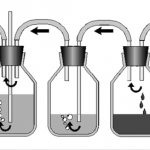Deep venous thrombosis is commonplace after multiple trauma. A systemic inflammatory process is activated, which leads to an increase in cytokine production. We know that a process called microvesiculation occurs, where cells undergoing apoptosis shed small particles that contain active tissue factor. These types of microparticles have been shown to lead to thrombosis in cancer patients, but the role in trauma patients has not been clear.
Researchers at the University of Rochester performed a simple study looking at injured or burned patients with an Apache II score >20 compared to normal controls. They examined blood drawn after day 2 in the hospital, and looked for microparticles using fluorescent microbeads. They concentrated on differences between 3 trauma patients who did not develop DVT and 2 who did.
Patients who developed DVT had nearly 300% more circulating microparticles than matched controls. It is likely that the majority of those microparticles expressed tissue factor as well.
Bottom line: This exciting work may help explain why trauma patients have a higher DVT rate. Additionally, it may eventually provide us with a blood test that will help pinpoint patients at high risk so we can provide more intensive surveillance and/or more aggressive prophylaxis or prevention.
Reference: Multisystem trauma patients who develop venous thromboembolism have increased numbers of circulating microparticles. Marlene Mathews MD et al. Presented at the 34th Annual Resident Trauma Paper Competition at the AmericanCollege of Surgeons Spring Meeting, Washington DC, 2011.



